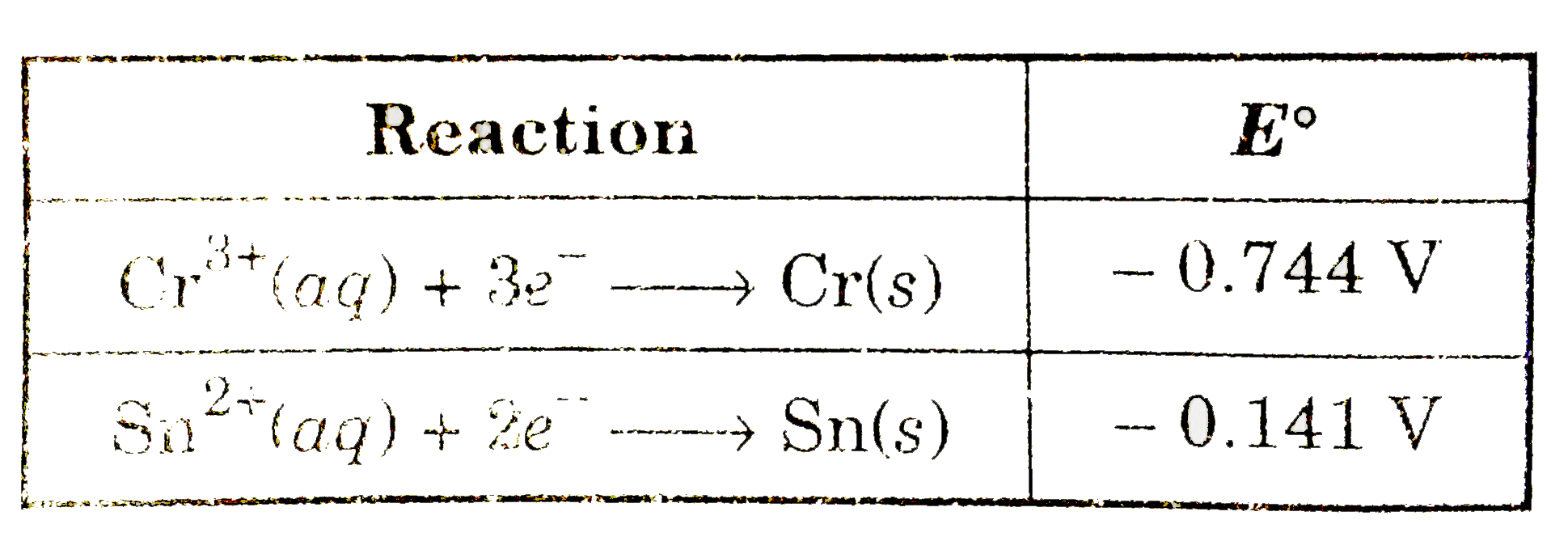The standard electrode potentials for the reactions,
Ag+(a.q)+e−→Ag(s)
Sn2+(a.q)+2e−→Sn(s) at 25∘C are 0.80 volt and −0.14 volt respectively. The emf of the cell
Sn∣∣Sn2+(1M)∣∣∣∣Ag+(1M)∣∣Ag is:
0.66 volt
0.80 volt
1.08 volt
0.94 volt
The correct Answer is:D
To find the emf (electromotive force) of the cell represented by the reaction:
Sn|Sn2+(1M)||Ag+(1M)|Ag
we will follow these steps:
Step 1: Identify the half-reactions and their standard electrode potentials.
The half-reactions given are:
1. For silver:
Ag+(aq)+e−→Ag(s)E∘=+0.80V
2. For tin:
Sn2+(aq)+2e−→Sn(s)E∘=−0.14V
Step 2: Determine the oxidation and reduction reactions.
In the cell, tin (Sn) will be oxidized and silver (Ag) will be reduced. Therefore, we need to reverse the tin half-reaction to represent oxidation:
Sn(s)→Sn2+(aq)+2e−E∘=+0.14V(oxidation potential)
Step 3: Calculate the overall cell potential (emf).
The overall cell potential (emf) can be calculated using the formula:
Ecell=Ereduction−Eoxidation
Here, the reduction potential for silver is +0.80V and the oxidation potential for tin is +0.14V.
Substituting the values:
Ecell=EAg−ESn=0.80V−0.14V
Ecell=0.80V+0.14V=0.94V
Final Answer:
The emf of the cell is 0.94V.
---
Ag+(aq)+e−→Ag(s)E∘=+0.80V
Sn2+(aq)+2e−→Sn(s)E∘=−0.14V
The emf of the cell is 0.94V.
Topper's Solved these Questions
- ELECTROCHEMISTRYBOOK - OP TANDONCHAPTER - ELECTROCHEMISTRYEXERCISE - OBJECTIVE TYPE QUESTION (LEVEL -B)
52 Videos
- ELECTROCHEMISTRYBOOK - OP TANDONCHAPTER - ELECTROCHEMISTRYEXERCISE - One or more than correct answer
19 Videos
- ELECTROCHEMISTRYBOOK - OP TANDONCHAPTER - ELECTROCHEMISTRYEXERCISE - PRACTICE PROBLEMS
94 Videos
- COORDINATION COMPOUNDSBOOK - OP TANDONCHAPTER - COORDINATION COMPOUNDSEXERCISE - SBJECTIVE TYPE
96 Videos
- HALOALKANES AND HALOARENES BOOK - OP TANDONCHAPTER - HALOALKANES AND HALOARENES EXERCISE - Single Interger answer type questions
14 Videos
Similar Questions
Consider the reaction,
2Ag++Cd→2Ag+Cd2+
The standard electrode potentials for Ag+→Ag and Cd2+→Cd couples are 0.80 volt and -0.40 volt respectively.
(i) What is the standard potential E∘ for this reaction ?
(ii) For the electrochemical cell, in which this reaction takes place which electrode is negative electrode ?
View SolutionWhat is the standard cell potential for the reaction,
2Cr(s)+3Sn2+(aq)→3Sn(s)+2Cr3+(aq)
given the E∘ values shown?

View Solution
Knowledge Check
The standard electrode potential for the reactions,
Ag+(aq)+e−→Ag(s)
Sn2+(aq)+2e−→Sn(s)
at 25∘C are 0.80 volt and −0.14 volt, respectively. The emfof the cell Sn∣∣Sn2+(1M)∣∣∣Ag+(1M)Ag is :A0.66voltB0.80 voltC1.08 voltD0.94 voltThe standard electrode potentials for the reactions
Ag+(aq)+e−→Ag(s)
Sn2+(aq)+2e−→Sn(s)
at 25∘C are 0.80 V and -0.14 V respectively The emf of the cell Sn∣∣Sn2+(1M)∣∣∣∣Ag+(1M)∣∣Ag isA0.48 VB0.80 VC1.08 VD0.94 vThe standard electrode potentials for the ractions
Ag+(aq)+e−→Ag(s)
sn+(aq)+2e−→Sn(s)
at 25∘C are 0.80 V and -0.14 V respectively the emf of the cell Sn∣∣Sn2+∣∣(1M)∣∣Ag+(1M)∣∣ Ag isA0.48 VB0.80 vC1.08 VD0.94 V
EoRP for Fe+2/FeandSn+2/Sn electrodes are −0.75and−0.45 volt respectively. The standard emf for cell F+2+Sn→Sn+2+Fe is :
View SolutionThe reaction, 12H2(g)+AgCl(s)=H+(a.q)+Cl−(a.q)+Ag(s) occurs in the galvanic cell:
View SolutionThe standard rectuion potentials for two half-cell reactions are given below
Cd2+(aq)+2e−→Cd(s),E∘=−0.40V
Ag+(aq)+e−→Ag(s),E∘=0.80V
The standard free energy change for the reaction
2Ag+(aq)+Cd(s)→2Ag(s)+Cd2+(aq) is given by
View SolutionThe standard electrode potentials (reduction) of Pt/Fe3+,Fe+2 and Pt/Sn4+,Sn+2 are +0.77V and 0.15V respectively at 25∘C. The standard EMF of the reaction Sn4++2Fe2+→Sn2++2Fe3+ is
View SolutionUse the standard reduction potentials:
Sn2+(aq)+2e−→Sn(s) E∘=−0.141V
Ag+(aq)+e−→Ag(s) E∘=0.800V
To calcultate E∘ for the reaction:
Sn(s)+2Ag+(aq)→Sn2+(aq)+2Ag(s)
View Solution
